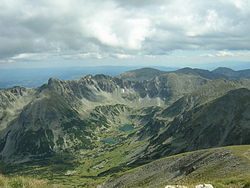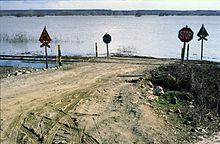Maritsa
| Maritsa Évros,Meriç | |
|---|---|
 The source valley of the Maritsa river in the Rila Mountains withMarichini Lakes | |
| Native name | |
| Location | |
| Countries | |
| Physical characteristics | |
| Source | |
| • location | Rila Mountains,Bulgaria |
| • elevation | 2,378 m (7,802 ft) |
| Mouth | |
• location | Aegean Sea,14.5 km (9.0 mi) east ofAlexandroupoli |
• coordinates | 40°43′50″N26°2′6″E/ 40.73056°N 26.03500°E |
| Length | 480 km (300 mi) |
| Basin size | 53,000 km2(20,000 sq mi)[1] |
| Discharge | |
| • average | for mouth 234 m3/s (8,300 cu ft/s)[2] |

MaritsaorMaritza(Bulgarian:Марица[mɐˈrit͡sɐ]), also known asEvros(Greek:Έβρος[ˈevros]) andMeriç(Turkish:Meriç[meɾit͡ʃ]), is ariverthat runs through theBalkansin Southeast Europe. With a length of 480 km (300 mi),[3]it is thelongest riverthat runs solely in the interior of theBalkan peninsula,and one of thelargest in Europe by discharge.It flows throughBulgariain its upper and middle reaches, while its lower course forms much of the border betweenGreeceandTurkey.Itsdrainage areais about 53,000 km2(20,000 sq mi), of which 66.2% is in Bulgaria, 27.5% in Turkey, and 6.3% in Greece.[1]It is the main river of the historical region ofThrace,most of which lies in itsdrainage basin.
It has its origin in theRila Mountainsin Western Bulgaria, its source being theMarichini Lakes.The Maritsa flows east-southeast between theBalkanandRhodope Mountains,pastPlovdivandDimitrovgradin Bulgaria toEdirnein Turkey. East ofSvilengrad,Bulgaria, the river flows eastwards, forming the border between Bulgaria (on the north bank) and Greece (on the south bank), and then between Turkey and Greece. At Edirne, the river meets it two chief tributariesTundzhaandArda,and flows through Turkish territory on both banks. It then turns towards the south and forms the border between Greece on the west bank and Turkey on the east bank all the way to theAegean Sea,which it enters nearEnez,forming ariver delta.The upper Maritsa valley is a principal east–west route in Bulgaria. The unnavigable river is used for hydroelectric power generation and irrigation.
Names
[edit]The earliest known name of the river isΕύρος(Euros,Alcman,7th–6th century BC).[4]Proto-Indo-European*h₁wérusandAncient Greekεὐρύςmeant "wide".[4]The Proto-Indo-Europeanconsonant cluster*-wr-shifted inThracianto-br-,creating the Thracian nameEbros.[4]Thereafter, the river began to be known asἝβρος(Hébros) in Greek andHebrusin Latin.[5]Rather than an origin as 'wide river', an alternative hypothesis is that is borrowed from Thracianebrosmeaning 'splasher'.[6]
While the nameἝβρος(Hébros) was used inAncient Greek,the nameΜαρίτσα(Maritsa) had become standard before the ancient formἝβροςwas restituted inModern GreekasΈβρος(now:Évros).[7]The nameMaritsamay derive from a mountain near the mouth of the river known in antiquity asΜηρισόςorΜήριζος,Latinized asMerit(h)us.[4][unreliable source?]
History
[edit]In 1371, the river was the site of theBattle of Maritsa,also known as the battle of Chernomen, anOttomanvictory over theSerbianrulersVukašin MrnjavčevićandJovan Uglješa,who died in the battle.
After 1923, the river gained political significance as the modern border betweenGreeceandTurkey.This was further bolstered by Greece joining theEuropean Unionin 1981 (and then theSchengen area), marking the river as an external boundary of the EU.
Since the 1990s, the river, as a natural barrier on the border between Turkey and Greece, has become a major route formigrantsfrom a variety of countries attempting to enter theEUirregularly.[8]Between 2000 and 2019, 398 bodies were found on the Greek side of the Maritsa/Evros river. Up until that time, drowning in the river was the leading cause of death among migrants trying to enter Greece.[9]
In February 2020, Turkey unilaterally opened its borders to Greece to allow refugees and migrants seeking refuge to reach the European Union, leading to the2020 Greek–Turkish border crisis.[10][11]In May 2020, news emerged that Turkish forces occupied 16 acres (6.5 ha) of Greek territory, Melissokomeio, as shown on maps of 1923, following a change in the flow of the river.[12]These crises passed following the improvement in Greek-Turkish relations in 2023, however, illegal migration is still a major issue.
Tributaries
[edit]

Starting from the river's source, significant tributaries of Maritsa include:
- Left tributaries:
- Topolnitsa(flows into Maritsa nearPazardzhik)
- Luda Yana(nearOgnyanovo)
- Stryama(nearSadovo)
- Sazliyka(nearSimeonovgrad)
- Tundzha/Tunca (inEdirne)
- Ergene(nearİpsala)
- Right tributaries:
- Chepinska reka(nearSeptemvri)
- Vacha(nearStamboliyski)
- Chepelarska reka(near Sadovo)
- Harmanliyska reka(nearHarmanli)
- Arda/Ardas (near Edirne)
- Erythropotamos/Luda reka (nearDidymoteicho)
Floods
[edit]

The lower course of the river Maritsa, where it forms the border between Greece and Turkey, is very vulnerable to flooding. For about 4 months every year, the low lands around the river are flooded. This causes significant economic damage (loss of agricultural production and damage to infrastructure), which is estimated at several hundreds million Euro.[13]
Recent large floods have taken place in 2006, 2007, 2014, with thelargest flood taking place in 2021.Several causes have been proposed, including more rainfall due to climate change, deforestation in the Bulgarian part of the catchment area, increased land use in the flood plains and difficult communication between the three countries.[13]
Trivia
[edit]Maritsa PeakonLivingston Islandin theSouth Shetland Islands,Antarcticais named after Maritsa River.
La Maritzais also a 1968 song written byJean RenardandPierre Delanoëand interpreted bySylvie Vartan.
Hebrus VallesonMarsis named after this river.
The BulgarianMaritsa motorway,which roughly follows the course of the river fromChirpan(where it branches out of theTrakia motorway) to the Turkish border atKapitan Andreevo,is also named in honour of the river.
Gallery
[edit]-
View from the river, Edirne.
-
The river viewed from Turkey. Greek land visible on the right.
-
Boat on the delta.
Notes
[edit]- ^ab"Preliminary Flood Risk Assessment"(in Greek). Ministry of Environment, Energy and Climate Change. p. 90. Archived fromthe originalon 15 February 2020.
- ^inweb.gr
- ^Statistical Yearbook 2017,National Statistical Institute (Bulgaria),p. 17
- ^abcdGeorgiev, Vladimir Ivanov Georgiev (1981).Introduction to the History of the Indo-European Languages (1981, p. 351).Publishing House of the Bulgarian Academy of Sciences.ISBN9789535172611.
- ^Florov, Nicholas; Florov, Irina (2001).Three-thousand-year-old Hat.Michigan University.ISBN9780968848708.
{{cite book}}:CS1 maint: location missing publisher (link) - ^Duridanov, Ivan (1985).Die Sprache der Thraker.Neuried: Hieronymus Verlag.ISBN978-3-88893-031-7.OCLC18925921.
- ^Schramm, Gottfried (1981): Eroberer und Eingesessene. Geographische Lehnnamen als Zeugen der Geschichte Südosteuropas im ersten Jahrtausend n. Chr. Stuttgart: Hiersemann, pp.290f. Referenced in Carsten Peust,How Old Are the River Names of Europe?,Linguistik Online, 2015
- ^Evros: The immigrants' gateway.PBS.org, May 16, 2011.
- ^Pavlidis, Pavlos; Karakasi, Maria-Valeria (2019). "Greek land borders and migration fatalities - Humanitarian disaster described from the standpoint of Evros".Forensic Science International.302:109875.doi:10.1016/j.forsciint.2019.109875.ISSN1872-6283.PMID31378400.S2CID199438113.
- ^Turkish police bolster Greek border to stop migrants' return.6 March 2020.
- ^Greece Defends Borders as Erdogan Opens the Gates: Live Updates.1 March 2020.
- ^"Athens lodges demarche with Ankara over Evros dispute".ekathimerini.com.22 May 2020.
- ^abEnvironmental management of big riverine floods: the case of Evros River in Greece,Z. Nivolianitou, B. Synodinou
References
[edit]- "МАРИЦА (антично име: Хеброс, Хебър)".Българска енциклопедия А-Я(in Bulgarian). БАН, Труд, Сирма. 2002.ISBN954-8104-08-3.OCLC163361648.
Further reading
[edit]- SKOULIKIDIS, NIKOLAOS TH., STAMATIS ZOGARIS, AND IOANNIS KARAOUZAS. Rivers of the Balkans. In Klement Tockner, Christiane Zarfl, and Christopher T. Robinson (eds.), Rivers of Europe, 2nd Ed. Cambridge, MA: Elsevier, 2022, pp. 593-654. ISBN 978-0-08-102612-0
- Maritsa
- Rivers of Bulgaria
- Rivers of Turkey
- International rivers of Europe
- Bulgaria–Greece border
- Greece–Turkey border
- Landforms of Edirne Province
- Landforms of Pazardzhik Province
- Landforms of Plovdiv Province
- Landforms of Haskovo Province
- Landforms of Sofia Province
- Landforms of Evros (regional unit)
- Rivers of Eastern Macedonia and Thrace
- Border rivers




